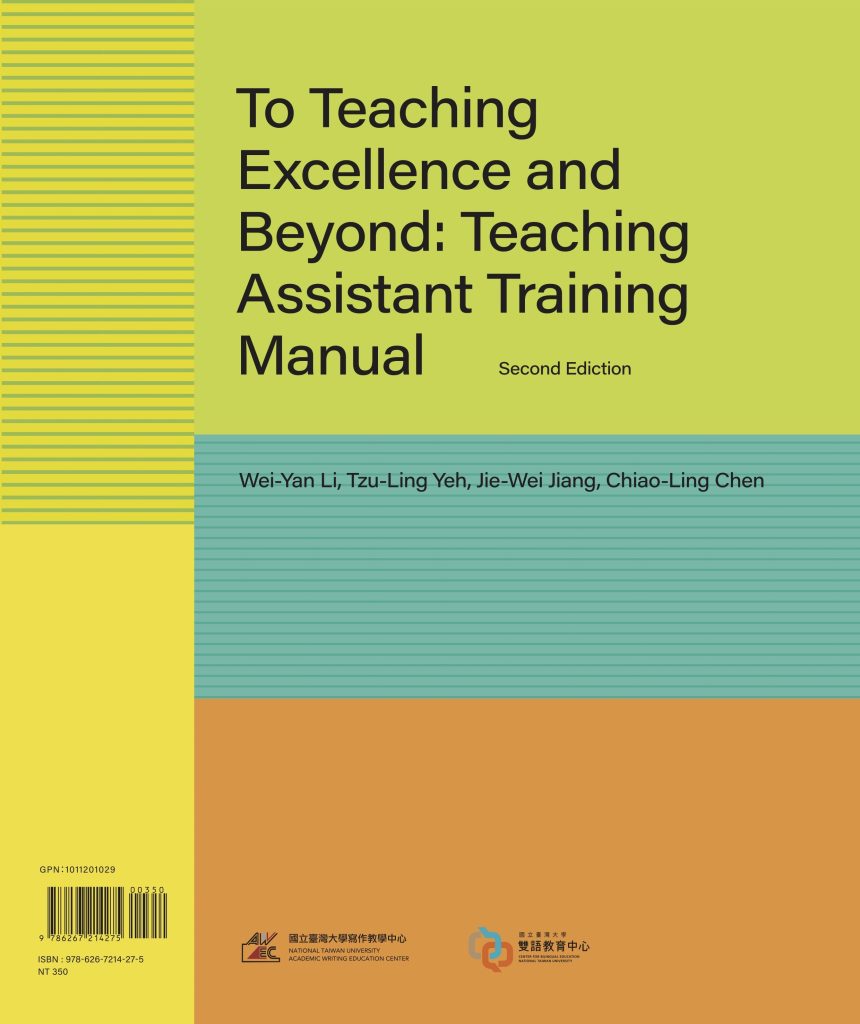

To Teaching Excellence and Beyond:
Teaching Assistant Training Manual
本書為臺大寫作教學中心之助教培訓用書,歷經三年實際試驗,從二十餘位傑出教學助理與教師的訪談,歸納出教學成功要訣,加上教學法與教學工具介紹,編纂而成。從助教內在自我特質探索,到外在教學技巧的加強,循序漸進。手冊內容分為三階段:第一是自我探索,了解助教角色定位及人格特質,有助於適才適所,充分發揮。第二則是教學反思,由傑出教學助理及教師分享在教學過程實際遭遇的難題,省思問題癥結,尋求因應之道。第三則是關於教學法及網路教學工具的介紹,盼助新手TA一臂之力。此外,全英語授課是未來高等教育的一大趨勢,助教的角色將更為吃重,本書特別增加EMI TA一章,介紹課堂實用語言公式、教學策略與工具等。在經過一年半EMI TA現場培訓經驗後,依學員回饋調整內容,以更貼近符合助教教學現場需求。另,第二版也新增ChatGPT在課堂上運用之策略與方法,協助TA快速就定位,善盡輔助之功。
Foreword
AWEC Director Wei-Yan Li
The establishment of teaching as a core value in contemporary higher education has elevated the importance attached to enhancing teaching quality and fostering excellent learning environments. To effect these important goals, not only are teachers urged to make continuous effort to hone their pedagogical prowess, but teaching assistants (TAs) are also deemed to play an increasingly significant role in classroom dynamics.
TAs are generally considered to play a passive role, extending assistance to teachers only in administering classrooms. However, if TAs avail themselves of existing resources and assume an active role, they are more than able to fulfill job obligations assigned by teachers. They are indeed a pedagogical force to be reckoned with, gaining wide recognition from students. More importantly, they have under their belt the pedagogical experience that lays a solid foundation for developing communication as a soft skill that future employment markets entail.
We at AWEC pride ourselves on laying considerable emphasis on the nurturing and mentoring of TAs. Initiated by the former director, Prof. I-Wen Su, the TA training program we have developed stands the test of time; over the years, AWEC TAs have received numerous awards. This achievement bestows upon us so strong a sense of confidence that we believe that the teaching facilitation and communicative methodology promoted in our program are fruitful and should therefore be shared with more teachers and TAs. It is this very belief that conceptualizes the writing of this training manual.
During the conceptualization, AWEC instructors interviewed two dozens of award-winning TAs with academic backgrounds in liberal arts, law, management, science, engineering, and biomedicine, as well as consulting a myriad of academic research papers. During the interviews, the instructors explored some collective challenges that these TAs had encountered in their classroom practices and advanced potential solutions to these challenges. The first five chapters, having undergone revisions and additions based on the feedback from the then in-training TAs, received content enrichment over a trial period of three years. Especially noteworthy is Chapter Six, the writing of which answers the concern over the promotion of the English as a medium of instruction (EMI) policy in higher education formulated by the Ministry of Education. Setting a relevant precedent, Chapter Six provides instructional tools and strategies that can be utilized in EMI classrooms within a short period of time for EMI-anxious teachers and TAs.
This TA training manual is intended as no encyclopedic guide. The beauty of this manual, we believe, lies in its provision of effortless and effective pedagogical strategies for novice teachers or TAs who cultivate fundamental pedagogical skills and those seasoned ones who pursue and sustain progress in pedagogical and communicative competence. Nevertheless, as teaching is rife with challenges of various forms of uncertainty, we realize that this TA training manual still has much scope of improvement. We will therefore genuinely look forward to and humbly appreciate feedback.